
New Brunswick is a city in and the seat of government of Middlesex County, in the U.S. state of New Jersey. A regional commercial hub for central New Jersey, the city is both a college town and a commuter town for residents commuting to New York City within the New York metropolitan area. New Brunswick is on the Northeast Corridor rail line, 27 miles (43 km) southwest of Manhattan. The city is located on the southern banks of the Raritan River in the heart of the Raritan Valley region.

Old Queens is the oldest extant building at Rutgers University and is the symbolic heart of the university's campus in New Brunswick in Middlesex County, New Jersey in the United States. Rutgers, the eighth-oldest college in the United States, was founded in 1766 during the American colonial period as Queen's College. Queen's College was named for Charlotte of Mecklenburg-Strelitz, the daughter of a German duke who became the queen consort of British king George III. Old Queens is located on a six-acre hilltop city block bounded by Somerset Street, Hamilton Street, College Avenue and George Street that was previously an apple orchard. Donated to the college in 1807 by James Parker, Jr., this city block become known the Queen's Campus and is the historic core of the university. Because of this, by metonymy, the name "Old Queens" came to be used as a reference to Rutgers College and is often invoked as an allusive reference to the university or to its administration.

The Eagleton Institute of Politics at Rutgers University was established in 1956 with an endowment from Florence Peshine Eagleton (1870–1953), and it focuses on state and national politics through education and public service. Ruth Mandel served as director for over 20 years, before being succeeded in that role by John Farmer Jr. in September, 2019, and Elizabeth C. Matto in September, 2022.

Poile Zedek Synagogue was a historic synagogue at 145 Neilson Street in New Brunswick, Middlesex County, New Jersey.
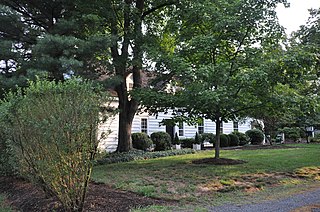
The Matthias Smock House is a historic house located at 851 River Road in the township of Piscataway in Middlesex County, New Jersey, United States. It was documented by the Historic American Buildings Survey (HABS) in 1938. The house was added to the National Register of Historic Places on December 4, 1973, for its significance in architecture. It was listed as a contributing property of the Road Up Raritan Historic District in 1997.

Red Maple Farm, also known as Gulick House, is a historic house and bed and breakfast located on Raymond Road west of the Monmouth Junction section of South Brunswick in Middlesex County, New Jersey. It was added to the National Register of Historic Places on July 3, 1979, for its significance in agriculture and architecture. In addition to the main house, a smoke house and barn contribute to the property.

The Sophia Astley Kirkpatrick Memorial Chapel, known as Kirkpatrick Chapel, is the chapel to Rutgers, The State University of New Jersey and located on the university's main campus in New Brunswick, New Jersey in the United States. Kirkpatrick Chapel is among the university's oldest extant buildings, and one of six buildings located on a historic section of the university's College Avenue Campus in New Brunswick known as the Queens Campus. Built in 1872 when Rutgers was a small, private liberal arts college, the chapel was designed by architect Henry Janeway Hardenbergh at the beginning of his career. Hardenbergh, a native of New Brunswick, was the great-great-grandson of Rutgers' first president, the Rev. Jacob Rutsen Hardenbergh. It was the third of three projects that Hardenbergh designed for the college.

Geology Hall is a historic building on the Queens Campus of Rutgers University, in New Brunswick, New Jersey. It was built from April 1871 to June 1872 to house various science classes and the Rutgers Geology Museum. The museum was established in 1872 by George Hammell Cook, Rutgers' then professor of geology, with a collection of specimens whose assembly began in the 1830s under Cook's predecessor, Lewis Caleb Beck. As classes and offices moved out of the hall, the museum expanded until it occupied the entire hall by the mid-20th century. In 1973, the hall was added to the New Jersey and National Register of Historic Places (NRHP) with Old Queens, President's House, Van Nest Hall, Daniel S. Schanck Observatory, the Kirkpatrick Chapel, and Winants Hall as part of the Old Queens Campus historic district.

Alexander Johnston Hall is a historic building located on the corner of Somerset Street and College Avenue, New Brunswick in Middlesex County, New Jersey and is the second oldest building on the campus of Rutgers University. It was built in 1830 to handle the expansion of the Rutgers Preparatory School and the two literary societies, Philoclean and Peithessophian. The building, described using its historic name, Rutgers Preparatory School, was added to the National Register of Historic Places on July 18, 1975 for its significance in architecture and education.
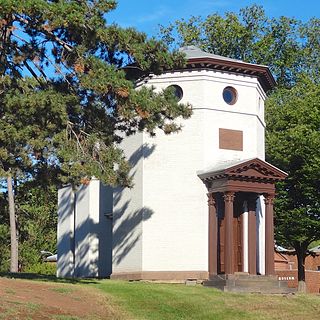
The Daniel S. Schanck Observatory is an historical astronomical observatory on the Queens Campus of Rutgers University in New Brunswick, New Jersey, United States, and is tied for the seventh oldest observatory in the US alongside the Vassar College Observatory. It is located on George Street near the corner with Hamilton Street, opposite the parking lot adjacent to Kirkpatrick Chapel, and to the northeast of Old Queens and Geology Hall.

The Queens Campus or Old Queens Campus is a historic section of the College Avenue Campus of Rutgers, The State University of New Jersey in New Brunswick, New Jersey, in the United States.

New Jersey Hall is a historic education building located on the campus of Rutgers University in New Brunswick, New Jersey. Built in 1889 under the leadership of President Merrill Edward Gates, it housed the Agricultural Experiment Station. It was added to the National Register of Historic Places on February 24, 1975, for its significance in agriculture and education.

The King Block, also known as the Crossroads Theater, was a historic building located on Memorial Parkway in the city of New Brunswick in Middlesex County, New Jersey, United States. It was added to the National Register of Historic Places on May 26, 1988, for its significance in commerce.
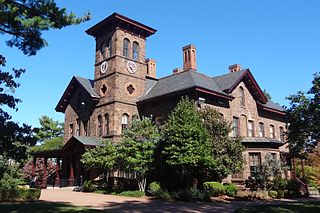
The Levi D. Jarrard House is a historic building located on the Douglass College campus of Rutgers University in New Brunswick, New Jersey. It was constructed in 1868 by an unknown architect, as a private residence for Levi D. Jarrard. Levi D Jarrard, was acting as Postmaster of New Brunswick from 1881-1883, but was previously employed as a New Jersey State Senator as well as the Middlesex County Collector. In 1883 he was found to have embezzled approximately $20,000, and had fled to Canada with the funds, leaving his family to struggle with payments on the house. The house was then purchased by John N. Carpender, who would later lease it to the New Jersey College for Women.

The Livingston Avenue Historic District is a historic district located along Livingston Avenue between Hale and Morris Streets in New Brunswick, Middlesex County, New Jersey. The district was added to the National Register of Historic Places on February 16, 1996, for its significance in architecture, social history, and urban history from 1870 to 1929. It has 58 contributing buildings and 2 contributing sites, including the Willow Grove Cemetery, the Henry Guest House, and the New Brunswick Free Public Library.

The Demarest House is a historic building at 542 George Street in New Brunswick, New Jersey on the campus of Rutgers University. It was documented by the Historic American Buildings Survey in 1960. The house was later added to the National Register of Historic Places on August 10, 1977 for its significance in architecture, education, and social history.

The James Bishop House, known as the Bishop House, is a historic building on the College Avenue campus of Rutgers University in New Brunswick, New Jersey. Bishop House was erected in 1852 for James Bishop, a prominent businessman and politician from New Brunswick in the latter half of 19th century. Located off of and facing College Avenue, the Bishop House is an example of an Italianate, or "Italian Villa" style mansion, popular from the 1850s to late 1870s in New Brunswick. Due to the building's significant associations with architecture, education, industry, politics and religion, it was added to the National Register of Historic Places on July 12, 1976.

John Neilson commanded the New Jersey militia in the northern part of the state during the American Revolution, served in the New Jersey legislature during and after the Revolution, and was one of the earliest trustees of Rutgers University. He is also notable for one of the earliest public readings of the Declaration of Independence, which was recently immortalized in a statue located at Monument Square Park in New Brunswick.
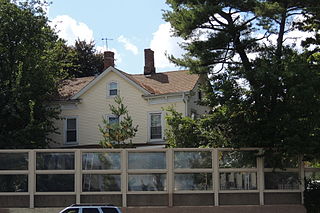
The Edward S. Kearney House is a historic house located at 9 New Jersey Route 18 in the Westons Mills section of East Brunswick in Middlesex County, New Jersey. It was added to the National Register of Historic Places on April 6, 1979, for its significance in architecture and commerce, one of only two historic taverns in the township.
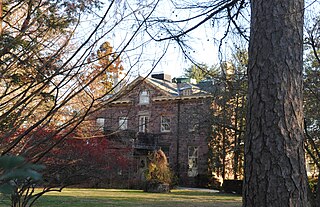
The Withington Estate, also known as the Heathcote Farm, is a 12.5-acre (5.1 ha) farmstead located on Spruce Lane near the Kingston section of South Brunswick in Middlesex County, New Jersey. The farm is adjacent to the Cook Natural Area and the Heathcote Brook. It was added to the National Register of Historic Places on September 27, 1984, for its significance in agriculture, architecture, landscape architecture and politics/government. In addition to the main residence, a stone barn and carriage house contribute to the property.

























